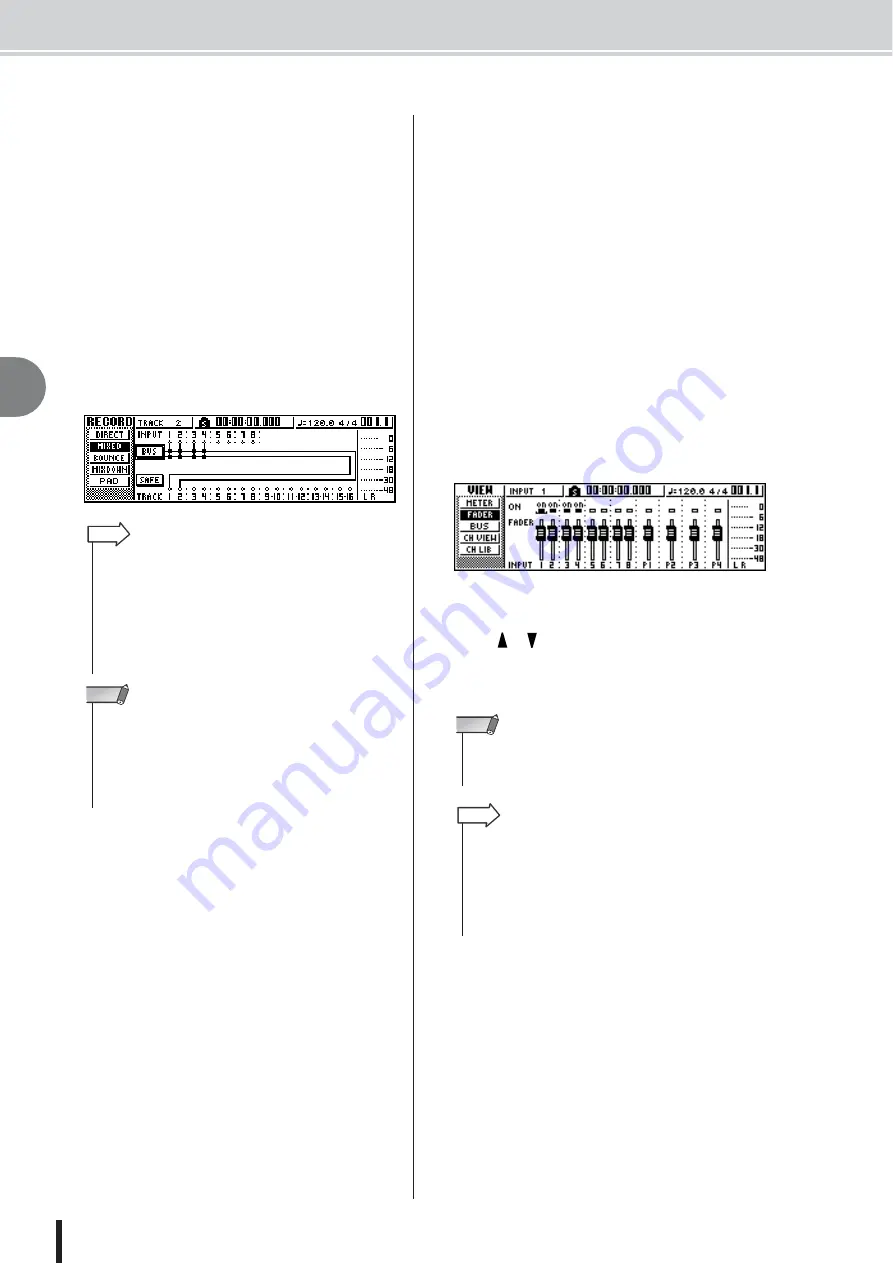
AW1600 Owner’s Manual
Assigning input signals to tracks (Bus recording)
5
Tr
ac
k recording
46
6
As necessary, use the same procedure to
specify other input channels as recording-
sources.
7
Press the [TRACK SEL] key(s) for the
record-destination track(s).
You can select up to two tracks as the record-destina-
tion.
If you select track 1, 3, 5, or 7, the signal will be con-
nected to bus L. If you select track 2, 4, 6, or 8, the sig-
nal will be connected to bus R. If you select tracks 9/
10–15/16, odd-numbered tracks will be connected to
bus L, and even-numbered tracks will be connected to
bus R.
The screen will display lines to indicate how the sig-
nals are connected to the track(s).
8
For each input channel to which you con-
nected an instrument or mic, press and
hold the [INPUT SEL] key to access the
INPUT SETTING popup window, and use
the [GAIN] knob to adjust the input level of
the signal.
For details on adjusting the input level, refer to
“Recording to a sound clip” (
9
Raise the [STEREO] fader to the 0 dB posi-
tion.
10
Raise the track channel fader for the
record-destination track, so that the moni-
tor level is appropriate.
Now you will be able to monitor the signal that is
being sent to the track(s) via the L/R bus.
11
To set the pan of each input channel, use
the [INPUT SEL] key to select a channel,
and turn the [PAN/BAL] knob of the
Selected Channel section.
When you use bus recording, it will not be possible to
adjust the pan or volume balance for individual instru-
ments after they have been recorded on the track(s).
This means that you must finalize the pan and volume
balance when you send the signals from the input
channels to the L/R bus.
12
To adjust the volume balance of each input
channel, repeatedly press the [VIEW] key in
the Selected Channel section to access the
FADER page.
When you want to set the volume balance of the input
channels, it is convenient to use the FADER page of
the VIEW screen. Here you can adjust the on/off status
and input levels for the input channels, pad channels,
and track channels — all in one page.
13
While producing sound on your instru-
ments, use the [INPUT SEL] keys or CUR-
SOR [
]/[
] keys to move the cursor to the
input channel that you want to control, and
turn the [DATA/JOG] dial to adjust the vol-
ume balance.
• EQ and dynamics settings will be flat for a track channel
whose track has been selected as a record-destination.
• If a single track is selected, the pan of the track channel will
be centered. If a paired track (
numbered/even-numbered track channels will be panned to
left and right respectively.
• The connection will be cancelled if you once again press the
[TRACK SEL] key of a currently selected track.
HINT
• The track numbers of muted tracks will be displayed as “M”
(mute), but you can still record to muted tracks.
• Since 24-bit songs can have a maximum of 8 play tracks (
p. 143), tracks 9 – 16 are muted and will not play back.
• The bit depth of a song can be verified via the SONG screen
LIST page.
NOTE
• We recommend that you not use the [GAIN] knob to adjust
the volume balance of the input channels. This will degrade
the S/N ratio, and may cause the sound to distort.
NOTE
• You can also use the INPUT LEVEL knob in the INPUT SET-
TING popup window to adjust the volume balance of the input
channels.
• Normally, the panel faders are dedicated to the track chan-
nels. However by changing an internal setting, you can use
the faders to control the input levels of the input channels. (
HINT
Summary of Contents for AW 1600
Page 1: ...Owner s Manual EN ...
Page 12: ...AW1600 Owner s Manual 1 Before you start 12 ...
Page 38: ...AW1600 Owner s Manual 38 4 Recording to a sound clip ...
Page 54: ...AW1600 Owner s Manual 54 5 Track recording ...
Page 228: ...AW1600 Owner s Manual 228 MEMO ...
Page 229: ...229 AW1600 Owner s Manual MEMO ...
Page 230: ...AW1600 Owner s Manual 230 MEMO ...
















































